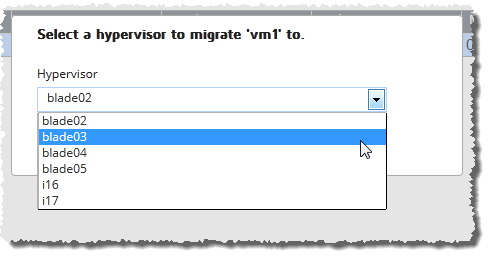Migrating a VM
From the Virtual Machine Management page, you can migrate your VMs to different hypervisors. These steps explain how this is to be done.
In order for VM migration to work properly, you must ensure that the VM migrates to a valid hypervisor that resides on the same VLAN as the VM's current hypervisor. Before you migrate a VM, make sure that you choose a hypervisor that matches these criteria.
The following is an example of a call you could make to MWS to find out which VLANs hypervisors are on. For example, run: http://<host>:8080/mws/rest/nodes?pretty=true&fields=id,hypervisorType,features, and examine the values.
{
"totalCount": 4,
"resultCount": 4,
"results": [
{
"features": ["vlan5"],
"hypervisorType": "esx",
"id": "blade03"
},
{
"features": ["vlan5"],
"hypervisorType": "",
"id": "blade04"
},
{
"features": ["vlan5"],
"hypervisorType": "esx",
"id": "blade05"
},
{
"features": ["vlan3"],
"hypervisorType": "esx",
"id": "i16"
}
]
}
hypervisorType can have a value ("esx," for example), or can be null. Those that have no value (null) are not real hypervisors; those that have a value are real hypervisors. Also, in this example, the features attribute displays which VLAN the hypervisor is on.
To migrate a VM
- Go to the Virtual Machine Management page (Administration > VM Management). For more information, see Fields: Virtual Machine Management.
- Identify the VM(s) in the list that you want to migrate. (You can search, sort, and page to find the VM you are looking for. For more information, see Searching, sorting, and filtering VMs.)
- Select the VM(s) you want to migrate.
- Choose Migrate.
- Select the hypervisor you want to use from the Hypervisor list.
- Choose Migrate to migrate the VM.

A window appears and prompts you to choose which hypervisor you want to migrate the VM to.
The destination hypervisor you select must be 1) a valid hypervisor, and 2) on the same VLAN as the current hypervisor. (For more information, see the note above.)

A confirmation statement appears and tells you if your request to migrate the VM(s) was submitted successfully or not.
Related topics